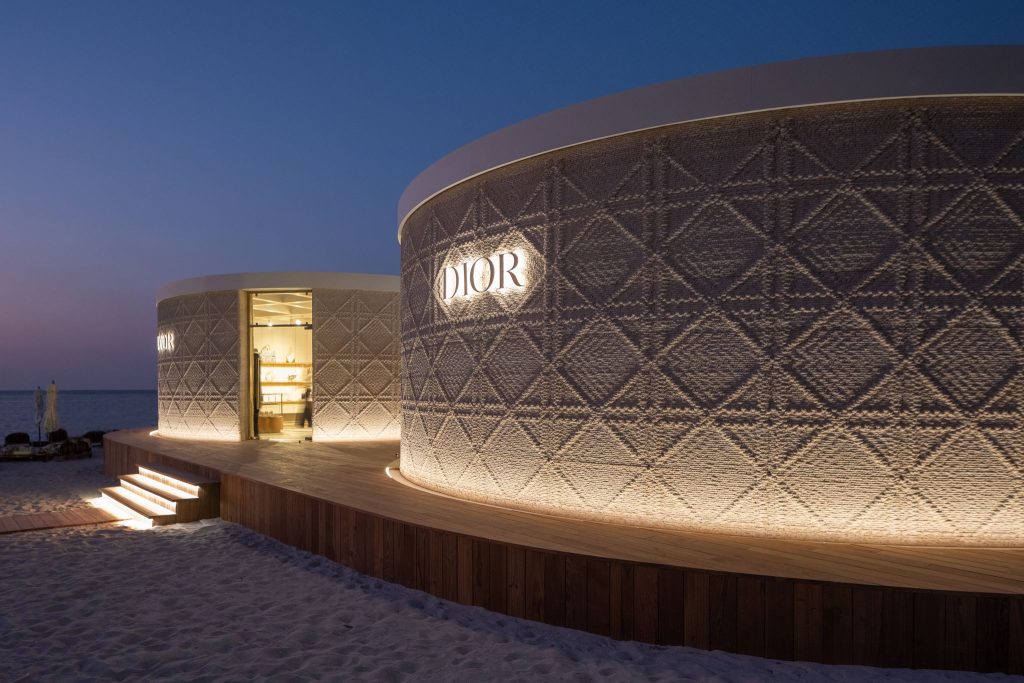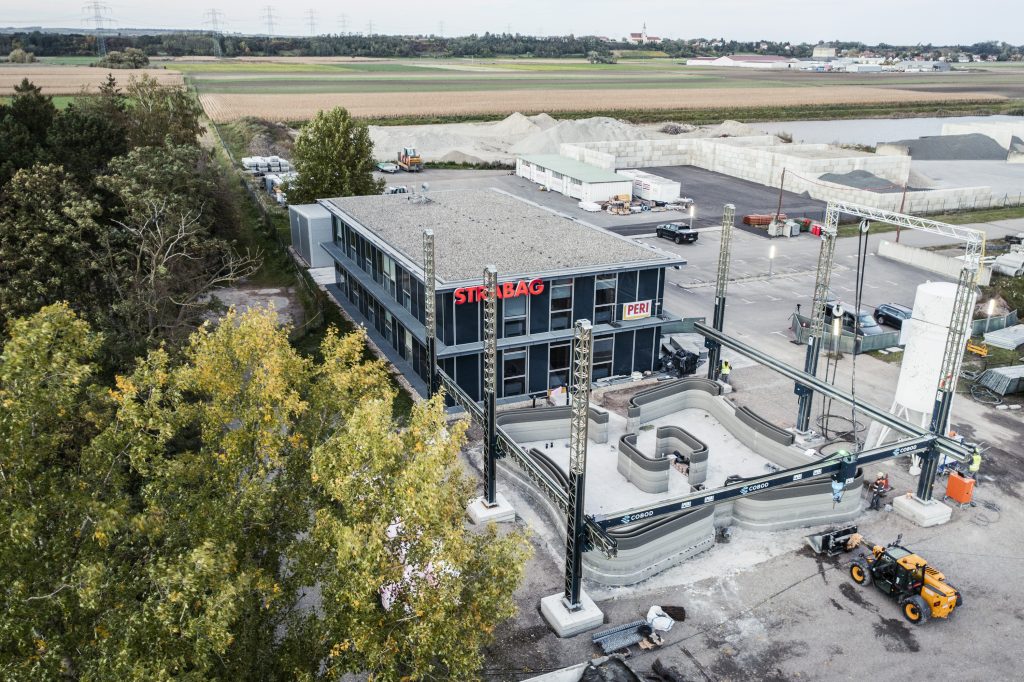Italian 3D printer manufacturer WASP and German building firm PERI have broken new ground with their latest additive manufacturing-led construction projects.
Elsewhere WASP has built a unique beach outlet for Dior from natural materials, which is now filled with the fashion designer’s latest merch, PERI has added to its construction credentials by unveiling Austria’s first 3D printed building, a 125 m² office it built with the help of LafargeHolcim for engineering firm STRABAG.
“Construction 3D printing brings an important innovation impulse for the construction industry and is an exciting addition to other construction methods,” said STRABAG board member Klemens Haselsteiner. “In Hausleiten [where the office has been built] we were able to achieve important findings for future use during [the project’s] joint planning.”
“With this practical test, we want to further develop construction 3D printing together with our partners PERI and Lafarge.”

Dior Dior galore in Dubai
Built on a beach in Dubai’s North Western Jumeirah district, Dior’s new coastal installation is composed of two large circular modules, and is designed to showcase the fashion house’s most sought after collections. In order to realize these seaside structures, the designer first enlisted the help of WASP, a company that specializes in the construction of sustainable infrastructure from local feedstocks.
Earlier this year, the firm finished 3D printing ‘TECLA,’ an eco-habitat constructed entirely from biomaterials, such as on-site soil, straw chopped rice, rice husk and hydraulic lime. Since then, WASP has gone on to create a similarly-sourced ‘house of dust’ sculpture near Germany’s Museum Wiesbaden, and on a smaller scale, it continues to work with Honda to apply its technologies in automotive areas too.
To construct Dior’s seaside boutique, the company stuck to its tried and tested approach, using one of its Delta 3D printers to deposit a combination of clay, sand and raw fibers into layers to form a stable (yet on-brand) pop-up store. Featuring an outer pattern that’s meant to reflect the designer’s signature purses, as well as a backlit Dior motif, the outlet has now been filled with many of its luxurious items.
In addition to beach essentials like deckchairs, parasols and cushions, the store also houses everything from opulent baskets to the fashion house’s classic ‘Book Tote’ and ‘Caro’ bags. While at first, the project may appear to be at odds with WASP’s aspirations to develop an accessible and sustainable housing model, its Founder Massimo Moretti says that Dior’s backing has been vital to its viability.
“Life is strange,” Moretti reportedly wrote on his Facebook page. “You start out developing a process to provide a home as a birthright to every human. You work on it for a decade, self-funding all research and development. Then comes Dior, a company that represents the world’s most refined luxury, and they ask you to print their stores, and they offer to finance your development costs.”

PERI achieves Austrian first
Like WASP, PERI has extensive construction 3D printing experience, but it has tended to target the more conventional housing market, rather than seeking to reshape it. The firm is a shareholder in 3D printer manufacturer COBOD, and just last year, it was able to deploy the company’s BOD2 system to erect a three-storey apartment building in Germany.
Over the 12 months or so since, PERI has steadily scaled its application of COBOD’s technologies, first building the world’s first housing extension, and now expanding into nearby Austria. Located in the hilly rural town of Hausleiten, the firm’s latest 3D printing project has seen it construct an office building from the ground up, next to one of STRABAG’s asphalt mixing facilities.
According to PERI, the extension was built using LafargeHolcim’s ‘Tector Print’ dry mortar which provided “long workability and good pumpability,” thus it was able to build the structure inside of 45 hours. The firm also credits the BOD2’s ability to move in any direction based on a single calibration as being beneficial, not just in this printing project, but the five others it has completed during the last year.
“Just under a year ago, we printed Germany’s first residential building with a BOD2 printer from our Danish partner COBOD,” said Thomas Imbacher, PERI’s Chief Innovation & Marketing Officer. “Now, together with our partners STRABAG and Lafarge, we are bringing this new form of construction to Austria and are delighted with the first printed office building in Hausleiten.”
“At PERI, we see great potential in the still young technology of 3D construction printing.”

$4M poured into wood 3D printing
Elsewhere in the world of construction 3D printing, the University of Idaho has gained $4 million from the National Science Foundation (NSF) to fund its research into wood-based building materials. Led by Michael Maughan, an Assistant Professor at the university’s College of Engineering, the team’s project revolves around the R&D of a 3D printer that’s capable of producing modular wall, floor and roof panels.
The prototype platform’s development comes at an interesting time for eco-friendly 3D printing materials, in which they’ve become more viable in the minds of manufacturers, with lignin-based biosynthetic polymers, such as those developed at the University of Freiburg, now being joined by Desktop Metal’s end-use ‘Forust’ wood binder jet 3D printing technology.
“We’re developing a new composite material, using completely bio-based resources on a truly large scale,” explained Maughan. “With this technology, houses and commercial buildings can be made entirely differently. We can push past climate change, mitigate impact on our environment and make better use of the natural resources we have.”
Specifically, the Idaho team is attempting to combine discarded fibers such as sawdust and offcuts from wood mills with a binding agent, to form a sustainable construction material. The engineers have also made optimizing their feedstock’s structural properties a key focus of their research, while making its resistance to fire, water damage a particular priority, so that it’s able to stand the test of time.
In terms of the multi-year project’s impact, the team expects it to help minimize the amount of waste produced by Idaho’s growing construction sector, something that Maughan says is not only damaging to the environment, but to companies’ profit margins too.
“Housing construction has very low productivity in terms of time invested and return,” added Maughan. “When you build a house, the contractors show up, they have to lift up the structure, frame it in. A number of things can disrupt the process — weather, manpower, tools, skill sets. It’s all very inefficient.”
To stay up to date with the latest 3D printing news, don’t forget to subscribe to the 3D Printing Industry newsletter or follow us on Twitter or liking our page on Facebook.
For a deeper dive into additive manufacturing, you can now subscribe to our Youtube channel, featuring discussion, debriefs, and shots of 3D printing in-action.
Are you looking for a job in the additive manufacturing industry? Visit 3D Printing Jobs for a selection of roles in the industry.
Featured image shows WASP’s Dior 3D printed buildings in Dubai. Photo via WASP.


